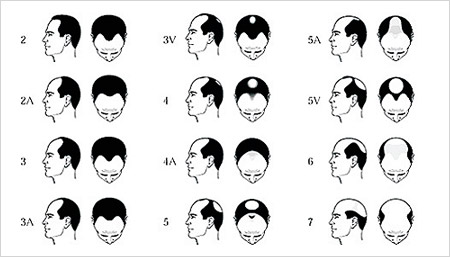Why and How Hair Loss in Men Occurs and the Best Treatment Options
As many as 85% of all men experience hair loss triggered by genetic factors related to testosterone, the predominant male hormone. Hair shedding and hair loss in men can begin as early as puberty.
Without treatment in the early stages, thinning hair can rapidly progress to baldness as hair follicles become inactive, stop producing hair and eventually die.

1. Testosterone infiltrates hair follicles through androgen receptor gateways. While inside the follicles, testosterone goes through enzyme reactions that produce Di-Hydro Testosterone (DHT). DHT is the root cause of shedding and hair thinning.
2. 5-alpha reductase (5AR), another enzyme within the hair follicle cells, converts testosterone to DHT.
3. Hair loss genes are activated by DHT which interacts with the DNA within the hair follicle cells. This causes an inhibition of normal hair growth.
4. As hair production slows, there is a weakening of follicles which produces finer and sparse hair growth. Over time, hair follicles die when hair production completely stops.
Male Pattern Hair Loss is the most common reason for shedding, loss and baldness in men. Less common causes include underlying health conditions such as autoimmune disease, hormone imbalance, severe trauma or medication side effects. The four types include:
- Male Pattern Hair Loss
- Alopecia Areata
Male Pattern Hair Loss
Approximately 95 percent of hair loss in men is due to male pattern hair loss from genetic causes and the production of DHT. Hair follicles stop producing normal hair replaced by thin, short, colorless hair, Eventually all hair production stops in areas of the scalp. This begins with a receding hairline and/or thinning at the crown of the head. Thinning can rapidly progress, resulting in bald spots, leaving the scalp appearance tight and shiny.
Alopecia Areata
Alopecia areata is a less common type of hair loss in children and adults caused by an autoimmune reaction. As the immune system attacks the hair follicles, smooth round patches of hair loss about the size of a coin, occur on the scalp and in the beard area.
- Telogen Eflluvium
- Traction Alopecia
Telogen Effluvium
A rare cause of hair loss, Telogen effuvium is caused by anemia, low iron, inadequate protein, thyroid disease, surgery or chronic illness. Massive hair shedding over the entire scalp occurs with this disorder. A major sign of this condition include sudden large amounts of hair in the hairbrush, on the pillow and in the shower of the affected person. With appropriate diagnosis and treatment, this condition generally reverses in six to 12 months without the need for further treatment.
Traction Alopecia
This type of hair loss is the result of excessive strain on the hair follicles and is often seen with braiding or ongoing pulling of the hair. Over time, this permanently damages the hair follicles and prevents hair from regrowing.
Male Hair Loss and Treatment FAQs
What is male pattern hair loss?
Responsible for 95% of all hair loss in men, male pattern is an inherited type of hair loss in which the male hormone testosterone enters the hair follicle cells through gateways known as androgen receptors. Through a combination of chemical reactions, Di-Hydro Testosterone (DHT) is produced and triggers hair thinning, shedding and hair loss.
Male pattern baldness generally starts in the twenties with a recession of hair in the temporal peaks and/or thinning in the crown. If left untreated, the extent of the baldness can extend from the front top of the head back to the crown, leaving a fringe of hair around the sides and back of the scalp.
Can hair loss be prevented?
Yes. Lifestyle factors including smoking, stress, medication and diet can play a major role with hair loss.
Smoking
There’s a clear link between lighting up and how fast male pattern baldness gets worse. So if you’re looking for one more good reason to quit, add early hair loss to the list
Stress, Medication and Diet
Certain medications, too much vitamin A, or not enough protein can lead to hair loss. Illness or severe stress can lead to sudden, heavy shedding called telogen effluvium. The good news is that hair loss that is not due to male pattern baldness responds well to early treatment.
Grow and Keep The Hair you Have
It’s easier to retain your existing hair than replace it once it’s gone. But be careful as you explore your options. Many “miracle” products and treatments are shams. When in doubt, your doctor or a dermatologist may be able to help.
Make Full Use of What You Have
Styling tricks can make hair loss stand out less. Cut thinning hair short so you can avoid a comb-over. DS Labs shampoos, conditioners, and re-growth serum products can add volume and thickness to what you do have. Also, eat a balanced diet, and handle your hair gently.
Who is a candidate for hair replacement?
Candidates for hair replacement treatments and procedures include:
- Men with male-pattern baldness
- Men with Alopecia Areata.( Baldness in spots).
- A person who has lost some but not all hair as a result of burns or other scalp injuries
- Hair loss from chemotherapy or other medications
- Men with thinning hair
- Men who are not candidates for hair regrowth due to long term male pattern baldness or hair loss from other causes that does not respond to treatment.
Should I wear a hair piece?
Hair pieces offer a very good solution for men when hair loss is extreme or in the advanced stages. Hair replacement has come a long way. It takes time and research to find the right hair replacement product because of a wide range in cost, fit, quality and comfort. And hairpieces also need regular maintenance which can run between $60 and $300 per month. When you’re shopping for one, it’s important to match your own hair color, thickness, and curl.

